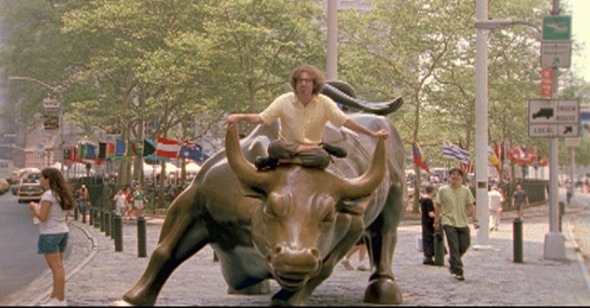Mind the Gap
Michael Koresky on Live from Shiva’s Dance Floor
Some public philosophers chose to react in relatively short order to the September 11th attacks with diatribes, instant responses that were meant to encapsulate all the world’s pain into frustratingly easy explanations and political I-told-you-so’s. Chomsky’s pocket-sized 9-11 seemed to materialize directly from his brain and onto Manhattan bookstore shelves; Sontag’s lambasted New Yorker article, an attempt to truly place the blame—i.e. that the terrorists were merely retaliating upon an evil empire that has taken advantage of them again and again—appeared a mere 13 days after the disaster. Regardless of how correct their opinions were, how steeped in historical precedent, how monumentally, cynically, horrifically plausible, the event simply required more time before analysis set in, before rationalization trumped mourning. Like many of us who chose not to get on the soapbox just yet, Linklater decided to take refuge in creation and the philosophies of others. His choice to film Live from Shiva’s Dance Floor in downtown Manhattan just months after the terrorist attacks was a natural extension of his twin artistic impulses: to express a political discontent and to do so by gleaning from the philosophies of others. Providing socio-historical commentary on New York landmarks past and present in the areas surrounding Wall Street and Battery Park is B-celebrity, cultural hanger-on, and blissed-out prophet Timothy “Speed” Levitch.
Also having appeared as the verbose buck-toothed, frizzy-haired apparition floating along the Brooklyn Bridge dreamscape in Waking Life, and later doing a cameo as a testy waiter in School of Rock, Levitch is now officially part of the Linklater troupe. Levitch perhaps best embodies the central contradiction in all of Linklater’s works: he is a seamless cross-pollination of the infantile and the philosophical—as with School of Rock’s Dewey Finn, Before Sunrise’s Jesse, and many of the unpolished thinkers of Slacker, Waking Life, and Dazed and Confused, a little buffoonery gets mixed up with the commentary. Levitch’s outlandish persona, bolstered by a nattering whine that sounds like a cross between Paul Lynde and Louie Anderson (can one imagine anything more grating?), functions here as it did in Bennett Miller’s documentary The Cruise, which followed him around as he narrated Manhattan bus tours: he is a benign theorist, not a truth-seeker as much as a dazed yet not-at-all confused pacifier.
Levitch's faith in life as “The Ongoing Wow” is meant to provide comfort to those disillusioned with their political realities. In his one-minute rant in Waking Life—with animated squiggles literalizing Levitch’s assertion of our lives as “adaptations of Dostoevsky novels starring clowns”—Levitch’s outlook is perhaps distilled better than in the 20 minutes of Live from Shiva’s Dance Floor; the events of 9/11 somehow make his observations, while refreshingly clear-eyed, seem slightly trite, a confounded clinging to ideals dated by a year. What’s most essential about the film is how much the act of training his camera solely, selflessly on Levitch reveals Linklater’s need to reconcile the city’s tragedy with the people that inhabit it; as in The Cruise, this is essentially a tour of New York with Levitch at the wheel, albeit with a landscape devastated by postwar fallout. The site of the former World Trade towers becomes a blank slate on which to project hope rather than despair; Levitch proposes a park rather than a memorial, something where families can enjoy the beauty that does, indeed surround them. So too does Linklater focus on presence rather than absence, providing imagery with monologue that’s meant to trump disillusionment and ease discomfort. Whether or not Levitch actually succeeds in doing so is beside the point: Linklater’s cinematic gesture is warm and not didactic, unable to provide answers to tragedy, he simply holds your hand.
